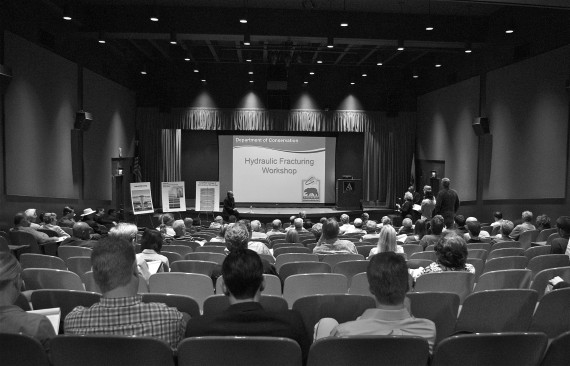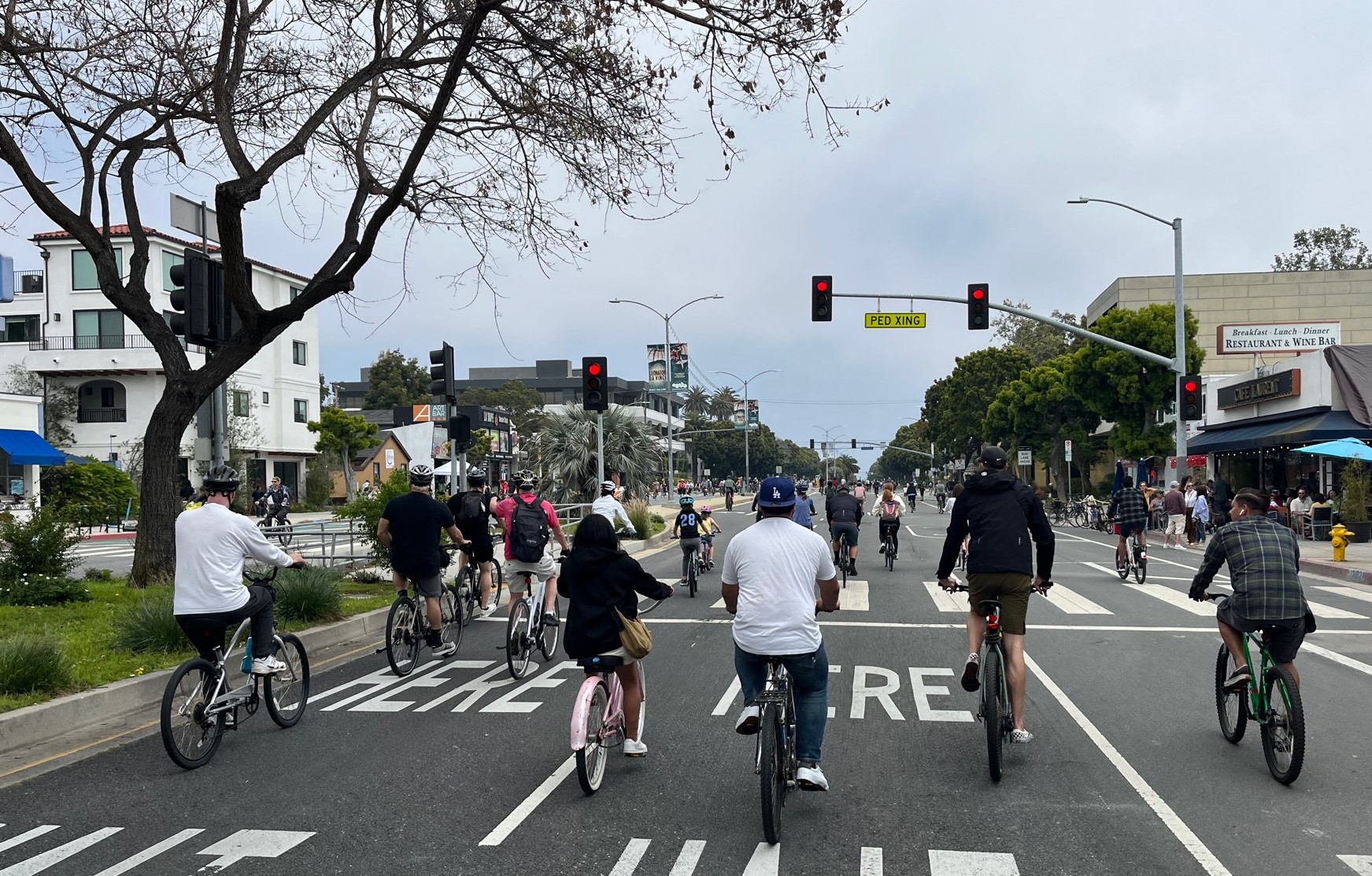The Artful DOGGR: DOGGR Embarks on a Listening Tour, is Told to Take a Fracking Leap
3:44 PM PDT on June 14, 2012
WHERE THE WORKSHOP ON HYDRAULIC FRACTURING, or "fracking," drew a record (and raucous) crowd in Culver City Tuesday night, the scene Wednesday night in Long Beach was more subdued. There was a steady stream of speakers ready to voice their concerns about the practice, but there were fewer of them and they were more reserved in their presentations.
This may, in part, be because of the limited outreach conducted prior to the workshop.
Why did she have to learn about the meeting through the news media, a frustrated woman wanted to know. Why hadn't the regulatory agency, the Department of Conservation’s Division of Oil, Gas, and Geothermal Resources (DOGGR), been more active in reaching out to residents?
Similarly, Milton, a community organizer from Communities for a Better Environment, asked why DOGGR had not conducted outreach in immigrant communities or provided their materials in languages other than English. Immigrants frequently reside in areas where drilling and other environmentally hazardous activities take place.
Both of them had a point. In addition to attendance being somewhat sparse, the demographic skewed much older, white, and well-to-do despite the socio-economic diversity of Long Beach and the proximity of the oilfields to the meeting site.
Their questions were met with silence.
In fact, very few questions were answered that evening, much to everyone's dismay.
The workshop was not intended to be a workshop in the sense of a give-and-take exchange. It was, instead, what a DOGGR representative termed a "listening session" or, a way for "us to just listen...[because] we want to make sure that we hear what the public is saying."
He explained DOGGR would draw from the informal input from the workshops and an independent scientific study of the practice of fracking to inform the development process of regulation governing its practice. Then, "in August or September of this year, we will come forward with a proposed regulation." The regulation will first go to Office of Administrative Law and then through the Rulemaking Process -- "a formal process of inquiring with the public [and] gathering questions."
While the first part of the process moves along rather quickly, once the formal inquiry stage begins, it can slow down significantly.
"Every single question you pose to us, once we've opened the regulatory process, we must respond to in writing, in a public way." He anticipated that they may have to answer as many as 60,000 questions in writing once the Rulemaking Process is launched in the fall.
Thus, this meeting was just the beginning of the process, not the end, the representative wanted to assure participants. And they were "taking copious notes" and "recording everything" for later review. (Although how well they were able to do that was questionable given that they had to halt the meeting several times because their batteries kept dying.)
The development of regulation itself is necessary because, as it stands, there is no real oversight of fracking.
No, really. There isn't.
As Department of Conservation Chief Deputy Director Jason Marshall put it at the meeting held in Baldwin hills in March, there is "no law that says 'Before you do a frack job, you have to tell DOGGR'...We're not required to be told of [a frack job]." (Watch parts 1 and 2 of the Baldwin Hills meeting.)
DOGGR only monitors the integrity of the wells.
In theory, in a perfect world, that approach could make sense. An issue with the pressure of a well would signal that something was amiss (a well casing had cracked, for example) and the process could be halted and the issue addressed.
The problem is that DOGGR is not on site where fracking is taking place. It is the drilling company itself which is responsible for providing DOGGR with data about the integrity of its own wells.
According the bill analysis of proposed legislation SB 1054, "well-casing failures are known to occur" and that "comprehensive data [about failures] are not available from DOGGR." Thus, the bill concludes, "it is difficult to specify or regulate design criteria for a well casing when all the conditions it is exposed to (e.g. fracking) are not known."
The conditions well casings are exposed to are not known because companies are not required to disclose what kinds of chemicals they are using to engage in fracking or the quantities in which they are being utilized. Not knowing the recipes of the chemical mixes means there can be no analysis of how these chemicals are interacting with each other or an accurate gauge what the ultimate environmental impact might be.
Recognizing the latter as a significant element of public concern, DOGGR recently sent a notice to their operators asking them to disclose the contents of their chemical concoctions on Fracfocus.org. Legislators are working on their own fix in proposed bill AB 591, which has already been watered-down significantly.
Although the letter strongly encourages companies to disclose the locations where they are fracking and the chemicals used in drilling, the strongest incentive DOGGR can offer for the voluntary disclosure is their appreciation.
Considering trade secrets are at stake, it would appear unlikely that their appreciation will spur anyone to have a change of heart.
I certainly didn't hear any change of heart in the voice of a supporter of the California Independent Petroleum Association (CIPA). He was pooh-poohing those who had concerns about the safety of their drinking water and touting "Truthland," CIPA's "factual alternative" to the documentary "Gasland."
He received applause from exactly one person as he finished his remarks.
"I would like to hear from community residents that are 'for' fracking," said the Communities for a Better Environment representative. He pointed out that we never hear from people whose land has been fracked who stand up and say how good the industry has been to their family or their health or their community.
"The only people who stand up for fracking are connected to the refineries."
My previous articles on fracking can be found here and here. If you'd like to add your voice to the mix with regard to the proposed regulation, please send your comments to DOGGR at comments@conservation.ca.gov or attend one of their workshops.
Sahra is Communities Editor for Streetsblog L.A., covering the intersection of mobility with race, class, history, representation, policing, housing, health, culture, community, and access to the public space in Boyle Heights and South Central Los Angeles.
Stay in touch
Sign up for our free newsletter
More from Streetsblog Los Angeles
Brightline West Breaks Ground on Vegas to SoCal High-Speed Rail
Brightline West will be a 218-mile 186-mile-per-hour rail line from Vegas to Rancho Cucamonga - about 40 miles east of downtown L.A. - expected to open in 2028
This Week In Livable Streets
Active Streets Mission-to-Mission, LAPD reports on its use of force in 2023, Pasadena Transit plans, Metro subway construction, and more
Eyes on the Street: Santa Monica Connection from E Line Bike Path to Downtown Is Almost Complete
“Always be closing gaps in your bikeway network.”
CicLAvia Opens Venice Boulevard – Open Thread
CicLAvia opened six miles of Venice Boulevard - from Culver City Station to Venice Beach





